Effect of Hydrogen Electrosorption on Mechanical and Electronic Properties of Pd80Rh20 Alloy
Abstract
1. Introduction
2. Materials and Methods
2.1. Material Preparation
2.2. Electrochemical Measurement Conditions
2.3. Material Characterization Methods
3. Results and Discussion
3.1. Microstructure Studies
3.2. Quantitative Study of Hydrogen Electrosorption
3.2.1. Two-step indirect absorption mechanism
3.2.2. One-step indirect absorption mechanism
3.3. Microindentation Hardness Testing
3.4. Nanoindentation
3.5. Determination of Work Function
4. Conclusions
Author Contributions
Funding
Acknowledgments
Conflicts of Interest
References
- Ball, M.; Basile, A.; Veziroğlu, T.N. Compendium of Hydrogen Energy, 1st ed.; Woodhead Publishing Series in Energy: Oxford, UK, 2016; Volume 4. [Google Scholar]
- Moliner, R.; Lázaro, M.J.; Suelves, I. Analysis of the strategies for bridging the gap towards the hydrogen economy. Int. J. Hydrog. Energ. 2016, 41, 19500–19508. [Google Scholar] [CrossRef]
- Rusman, N.A.A.; Dahari, M. A review on the current progress of metal hydrides material for solid-state hydrogen. Int. J. Hydrog. Energ. 2016, 41, 12108–12126. [Google Scholar] [CrossRef]
- Lewis, F.A. The Palladium Hydrogen System; Academic Press Inc.: London, UK; New York, NY, USA, 1967. [Google Scholar]
- Lewis, F.A. The palladium-hydrogen system: structures near phase transition and critical points. Int. J. Hydrog. Energ 1995, 20, 587–592. [Google Scholar] [CrossRef]
- Łukaszewski, M.; Czerwiński, A. The method of limited volume electrodes as a tool for hydrogen electrosorption studies in palladium and its alloys. J. Solid State Electrochem. 2011, 15, 2489–2522. [Google Scholar] [CrossRef]
- Yamauchi, M.; Ikeda, R.; Kitagawa, H.; Takata, M. Nanosize effects on hydrogen storage in palladium. J. Phys. Chem. C 2008, 112, 3294–3299. [Google Scholar] [CrossRef]
- Birry, L.; Lasia, A. Effect of crystal violet on the kinetics of H sorption into Pd. Electrochim. Acta 2006, 51, 3356–3364. [Google Scholar] [CrossRef]
- Łosiewicz, B.; Birry, L.; Lasia, A. Effect of adsorbed carbon monoxide on the kinetics of hydrogen electrosorption into palladium. J. Electroanal. Chem. 2007, 611, 26–34. [Google Scholar] [CrossRef]
- Jurczakowski, R.; Łosiewicz, B.; Lasia, A. Kinetic and thermodynamic parameters of hydrogen sorption in Pd, Pd-Pt and on Pt. ECS Trans. 2007, 2, 11–19. [Google Scholar] [CrossRef]
- Duncan, H.; Lasia, A. Mechanism of hydrogen adsorption/absorption at thin Pd layers on Au(111). Electrochim. Acta 2007, 52, 6195–6205. [Google Scholar] [CrossRef]
- Duncan, H.; Lasia, A. Hydrogen adsorption/absorption on Pd/Pt(111) multilayers. J. Electroanal. Chem. 2008, 621, 62–68. [Google Scholar] [CrossRef]
- Duncan, H.; Lasia, A. Separation of hydrogen adsorption and absorption on Pd thin films. Electrochim. Acta 2008, 53, 6845–6850. [Google Scholar] [CrossRef]
- Martin, M.H.; Lasia, A. Study of the hydrogen absorption in Pd in alkaline solution. Electrochim. Acta 2008, 53, 6317–6322. [Google Scholar] [CrossRef]
- Martin, M.H.; Lasia, A. Hydrogen sorption in Pd monolayers in alkaline solution. Electrochim. Acta 2009, 54, 5292–5299. [Google Scholar] [CrossRef]
- Adams, B.D.; Chen, A. The role of palladium in a hydrogen economy. Mater. Today 2011, 14, 282–289. [Google Scholar] [CrossRef]
- Ouyang, L.; Huang, J.; Wang, H.; Liu, J.; Zhu, M. Progress of hydrogen storage alloys for Ni-MH rechargeable power batteries in electric vehicles: A review. Mater. Chem. Phys. 2017, 200, 164–178. [Google Scholar] [CrossRef]
- Hubkowska, K.; Łukaszewski, M.; Koss, U.; Czerwiński, A. Characterization and electrochemical behavior of Pd-rich Pd-Ru alloys. Electrochim. Acta 2014, 132, 214–222. [Google Scholar] [CrossRef]
- Hubkowska, K.; Łukaszewski, M.; Czerwiński, A. Thermodynamics of hydride formation and decomposition in electrodeposited Pd-rich Pd-Ru alloys. Electrochem. Commun. 2014, 48, 40–43. [Google Scholar] [CrossRef]
- Sharma, B.; Myung, J. Pd-based ternary alloys for gas sensing applications: A review. Int. J. Hydrogen Energy 2019, 44, 30499–30510. [Google Scholar] [CrossRef]
- Du, L.; Feng, D.; Xing, X.; Fu, Y.; Fonseca, L.F.; Yang, D. Palladium/cobalt nanowires with improved hydrogen sensing stability at ultra-low temperatures. Nanoscale 2019, 11, 21074–21080. [Google Scholar] [CrossRef]
- Dos Santos, D.S.; Miraglia, S.; Fruchart, D. Effects of cathodic charging on hydrogen permeation in a Pd80Rh20 alloy. J. Alloy Compd. 2004, 383, 213–218. [Google Scholar] [CrossRef]
- Comisso, N.; De Ninno, A.; Del Giudice, E.; Mengoli, G.; Soldan, P. Electrolytic hydriding of Pd79.5Rh20.5 alloy. Electrochim. Acta 2004, 49, 1379–1388. [Google Scholar] [CrossRef]
- Siwek, H.; Łukaszewski, M.; Czerwiński, A. Electrosorption of carbon dioxide on Rh binary alloys with Pt and Pd. Pol. J. Chem. 2004, 78, 1121–1133. [Google Scholar]
- Żurowski, A.; Łukaszewski, M.; Czerwiński, A. Electrosorption of hydrogen into palladium-rhodium alloys. Electrochim. Acta 2006, 51, 3112–3117. [Google Scholar] [CrossRef]
- Łukaszewski, M.; Żurowski, A.; Grdeń, M.; Czerwiński, A. Correlations between hydrogen electrosorption properties and composition of Pd-noble metal alloys. Electrochem. Commun. 2007, 9, 671–676. [Google Scholar] [CrossRef]
- Żurowski, A.; Łukaszewski, M.; Czerwiński, A. Electrosorption of hydrogen into palladium-rhodium alloys; Part 2. Pd-rich electrodes of various thickness. Electrochim. Acta 2008, 53, 7812–7816. [Google Scholar] [CrossRef]
- Flanagan, T.B.; Baranowski, B.; Majchrzak, S. Remarkable interstitial hydrogen contents observed in rhodium-palladium alloys at high pressures. J. Phys. Chem. 1970, 74, 4299–4300. [Google Scholar] [CrossRef]
- Łosiewicz, B.; Lasia, A. Study of the hydrogen absorption/diffusion in Pd80Rh20 alloy in acidic solution. J. Electroanal. Chem. 2018, 822, 153–162. [Google Scholar] [CrossRef]
- Łosiewicz, B.; Kubisztal, J. Effect of hydrogen electrosorption on corrosion resistance of Pd80Rh20 alloy in sulfuric acid: EIS and LEIS study. Int. J. Hydrog. Energ. 2018, 43, 20004–20010. [Google Scholar] [CrossRef]
- Łosiewicz, B.; Jurczakowski, R.; Lasia, A. Kinetics of hydrogen underpotential deposition at polycrystalline rhodium in acidic solutions. Electrochim. Acta 2011, 56, 5746–5753. [Google Scholar] [CrossRef]
- Lasia, A. Electrochemical Impedance Spectroscopy and its Applications; Springer: New York, NY, USA, 2014. [Google Scholar]
- Vigier, F.; Jurczakowski, R.; Lasia, A. Determination of hydrogen absorption isotherm and diffusion coefficient in Pd81Pt19 alloy. J. Electroanal. Chem. 2006, 588, 32–43. [Google Scholar] [CrossRef]
- Khrushchov, M.M.; Berkovich, E.S. Methods of determining the hardness of very hard materials: The hardness of diamond. Ind. Diam. Rev. 1951, 11, 42–49. [Google Scholar]
- Łosiewicz, B.; Popczyk, M.; Szklarska, M.; Smołka, A.; Osak, P.; Budniok, A. Application of the scanning Kelivin probe technique for characterization of corrosion interfaces. Solid State Phenom. 2015, 228, 369–382. [Google Scholar] [CrossRef]
- Jerkiewicz, G. Electrochemical hydrogen adsorption and absorption. Part 1: Under-potential deposition of hydrogen. Electrocatal. 2010, 1, 179–199. [Google Scholar] [CrossRef]
- Bagotskaya, I.A. Effect of the solution composition on the diffusion rate of electrolytic hydrogen. Zh. Fiz. Khim. 1962, 36, 2667–2673. [Google Scholar]
- Frumkin, A.N.; Delahay, P.J. (Eds.) Advances in Electrochemistry and Electrochemical Engineering, Vol. 3: Electrochemistry; Interscience Publishers: London, UK; New York, NY, USA, 1963. [Google Scholar]
- Zheng, G.; Popov, B.N.; White, R.E. Hydrogen-atom direct-entry mechanism into metal membranes. J. Electrochem. Soc. 1995, 142, 154–156. [Google Scholar] [CrossRef]
- Chen, J.S.; Diard, J.P.; Durand, R.; Montella, C. Hydrogen insertion reaction with restricted diffusion. Part 1. Potential step—EIS theory and review for the direct insertion mechanism. J. Electroanal. Chem. 1996, 406, 1–13. [Google Scholar] [CrossRef]
- Łosiewicz, B.; Jurczakowski, R.; Lasia, A. Kinetics of hydrogen underpotential deposition at polycrystalline platinum in acidic solutions. Electrochim. Acta 2012, 80, 292–301. [Google Scholar] [CrossRef]
- Łosiewicz, B.; Martin, M.; Lebouin, C.; Lasia, A. Kinetics of hydrogen underpotential deposition at ruthenium in acidic solutions. J. Electroanal. Chem. 2010, 649, 198–205. [Google Scholar] [CrossRef]
- Łosiewicz, B.; Jurczakowski, R.; Lasia, A. Kinetics of hydrogen underpotential deposition at iridium in sulfuric and perchloric acids. Electrochim. Acta 2017, 225, 160–167. [Google Scholar] [CrossRef]
- Brug, G.J.; Van den Eeden, A.L.G.; Sluyters-Rehbach, M.; Sluyters, J.H. The analysis of electrode impedances complicated by the presence of a constant phase element. J. Electroanal. Chem. 1984, 176, 275–295. [Google Scholar] [CrossRef]
- Agmon, N.; Bakker, H.J.; Campen, R.K.; Henchman, R.H.; Pohl, P.; Roke, S.; Thämer, M.; Hassanali, A. Protons and hydroxide ions in aqueous systems. Chem. Rev. 2016, 116, 7642–7672. [Google Scholar] [CrossRef] [PubMed]
- Marcus, Y. Volumes of aqueous hydrogen and hydroxide ions at 0 to 200 °C. J. Chem. Phys. 2012, 137, 154501. [Google Scholar] [CrossRef] [PubMed]
- Kirchner, B. Eigen or Zundel ion: News from calculated and experimental photoelectron spectroscopy. Chem. Phys. Chem. 2007, 8, 41–43. [Google Scholar] [CrossRef] [PubMed]
- Mella, M. Exploring unvisited regions to investigate solution properties: The backyard of H3O+ and its aggregates. Chem. Phys. Lett. 2013, 555, 51–56. [Google Scholar] [CrossRef]
- Nichols, R.J.; Lipkowski, J.; Ross, P.N. (Eds.) Adsorption of Molecules at Metal Electrodes, Chapter 7; VCH: New York, NY, USA, 1992. [Google Scholar]
- Christman, K. Interaction of hydrogen with solid surfaces. Surf. Sci. Rep. 1988, 9, 1–163. [Google Scholar] [CrossRef]
- Raub, E. Metals and alloys of the platinum group. J. Less-Common. Met. 1959, 1, 3–18. [Google Scholar] [CrossRef]
- Flanagan, T.B.; Wang, D.; Clewley, J.D.; Noh, H. Hydrogen solubility in ternary Pd0.90Rh0.1-xNix and Pd0.90Rh0.1-xCox alloys. J. Alloy Comp. 2000, 305, 172–182. [Google Scholar] [CrossRef]
- Li, X.; Nardi, P.; Baek, C.W.; Kim, J.M.; Kim, Y.K. Direct nanomechanical machining of gold nanowires using a nanoindenter and an atomic force microscope. J. Micromech. Microeng. 2005, 15, 551–556. [Google Scholar] [CrossRef]
- Haynes, W.M. Handbook of Chemistry and Physics, 97th ed.; CRC Press: Boca Raton, FL, USA, 2016. [Google Scholar]
- Onuferko, J.H.; Woodruff, D.P.; Holland, B.W. LEED structure analysis of the Ni{100} (2 × 2)C (p4g) structure; A case of adsorbate-induced substrate distortion. Surf. Sci. 1979, 87, 357–374. [Google Scholar] [CrossRef]
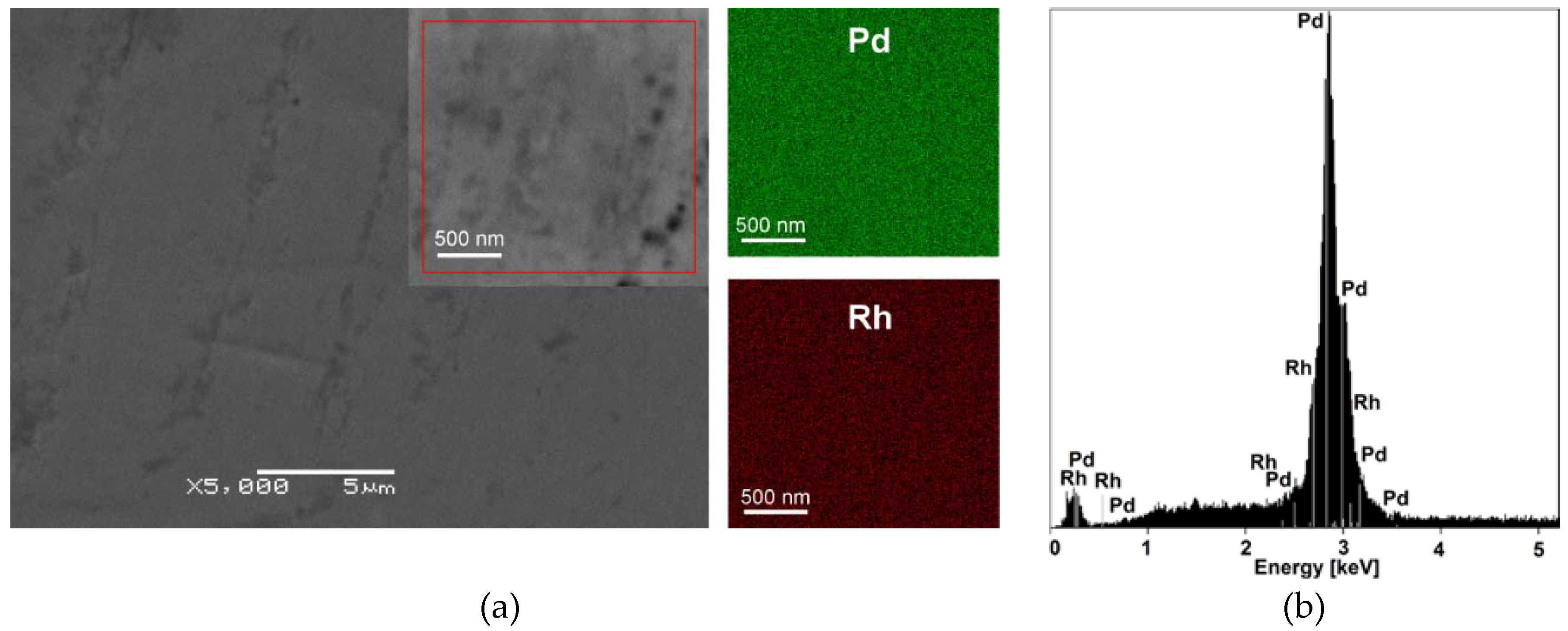

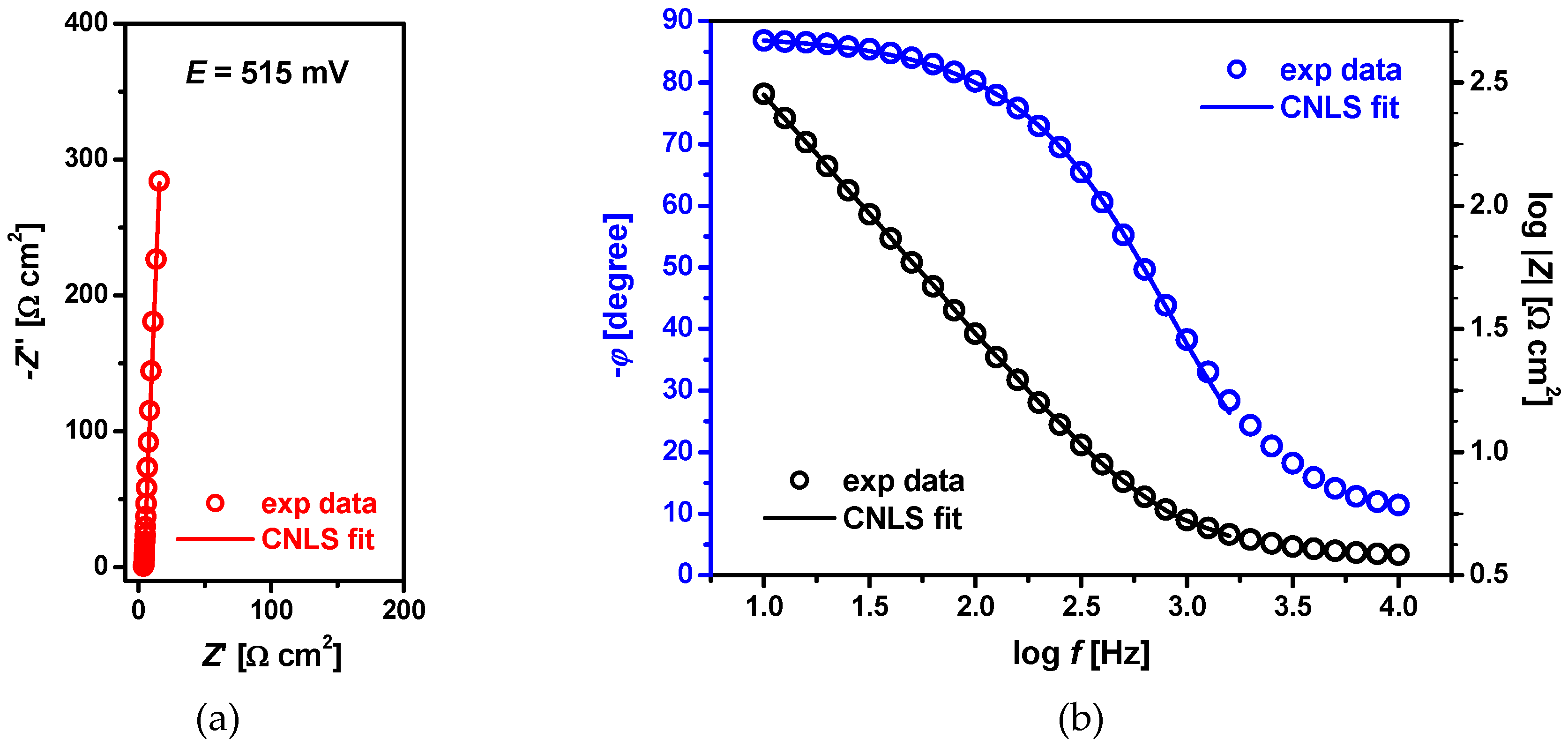
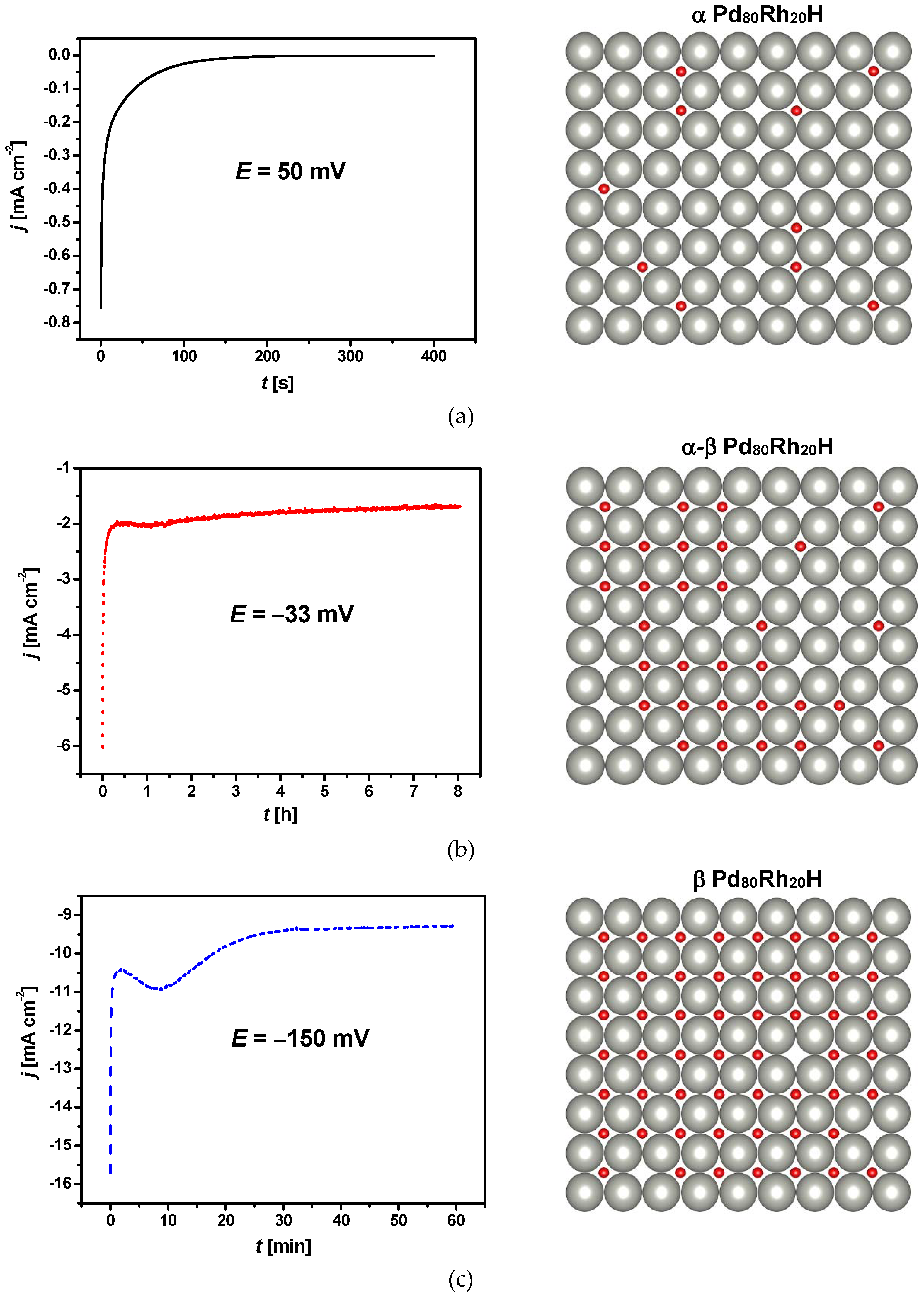
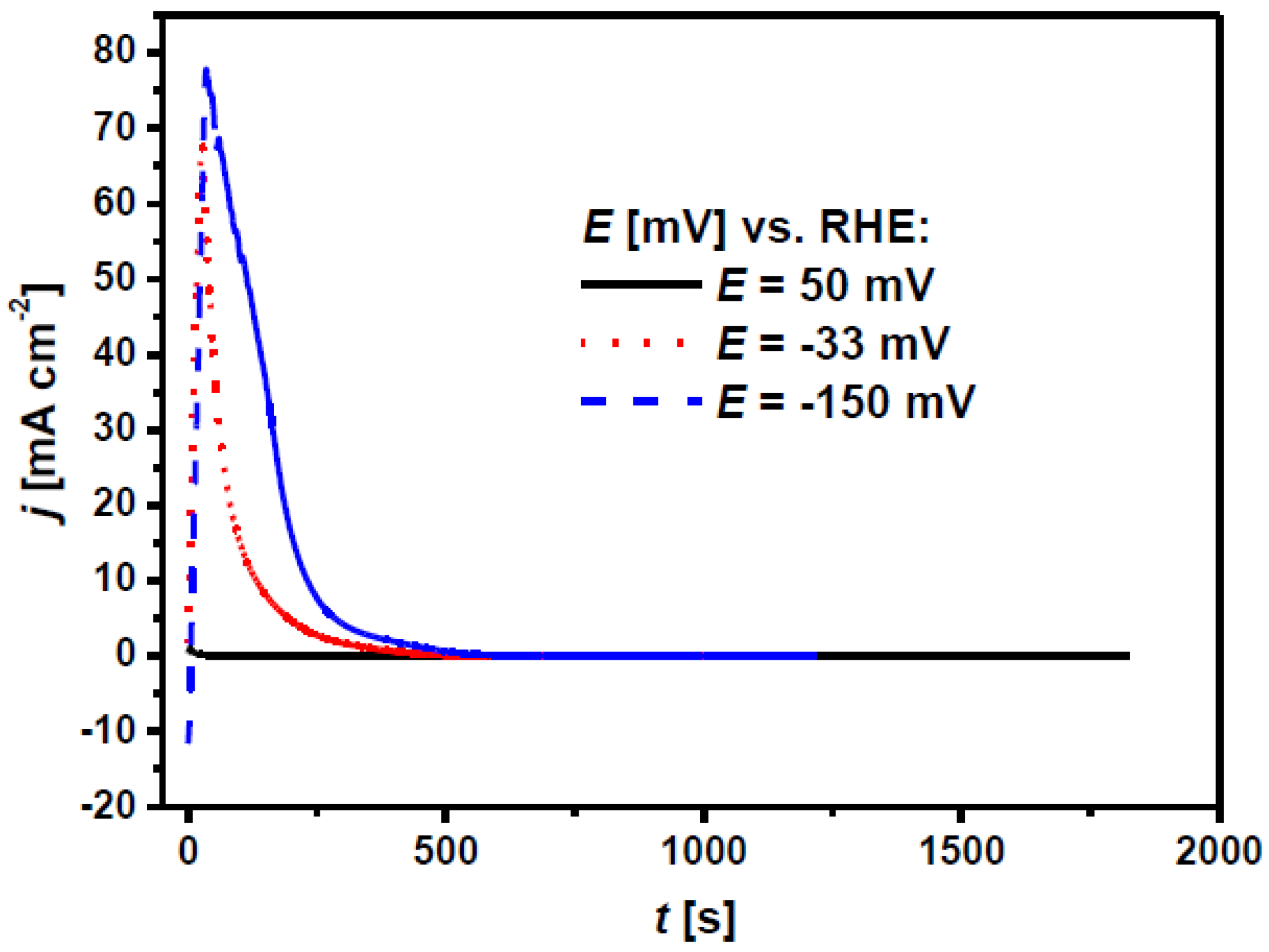

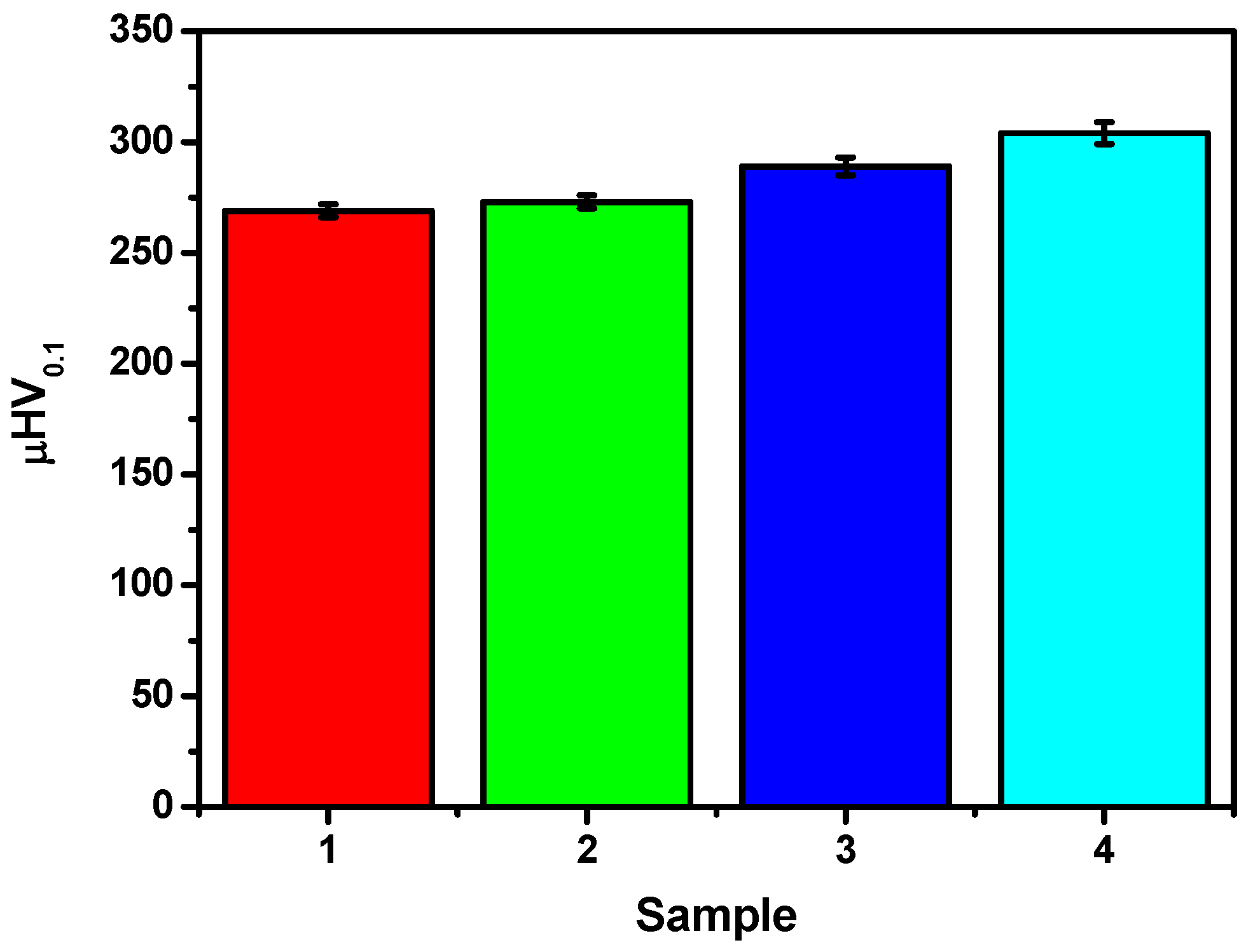


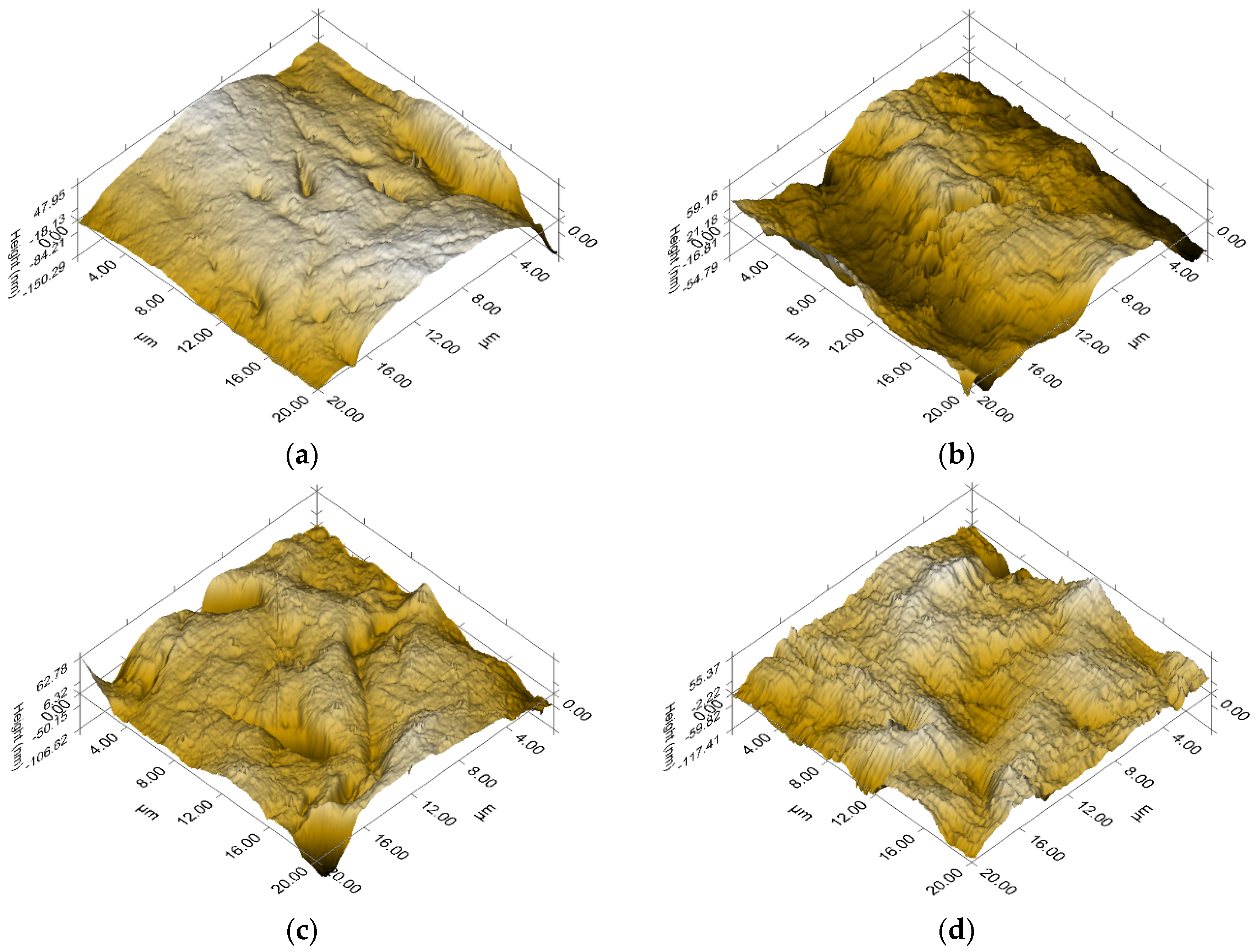
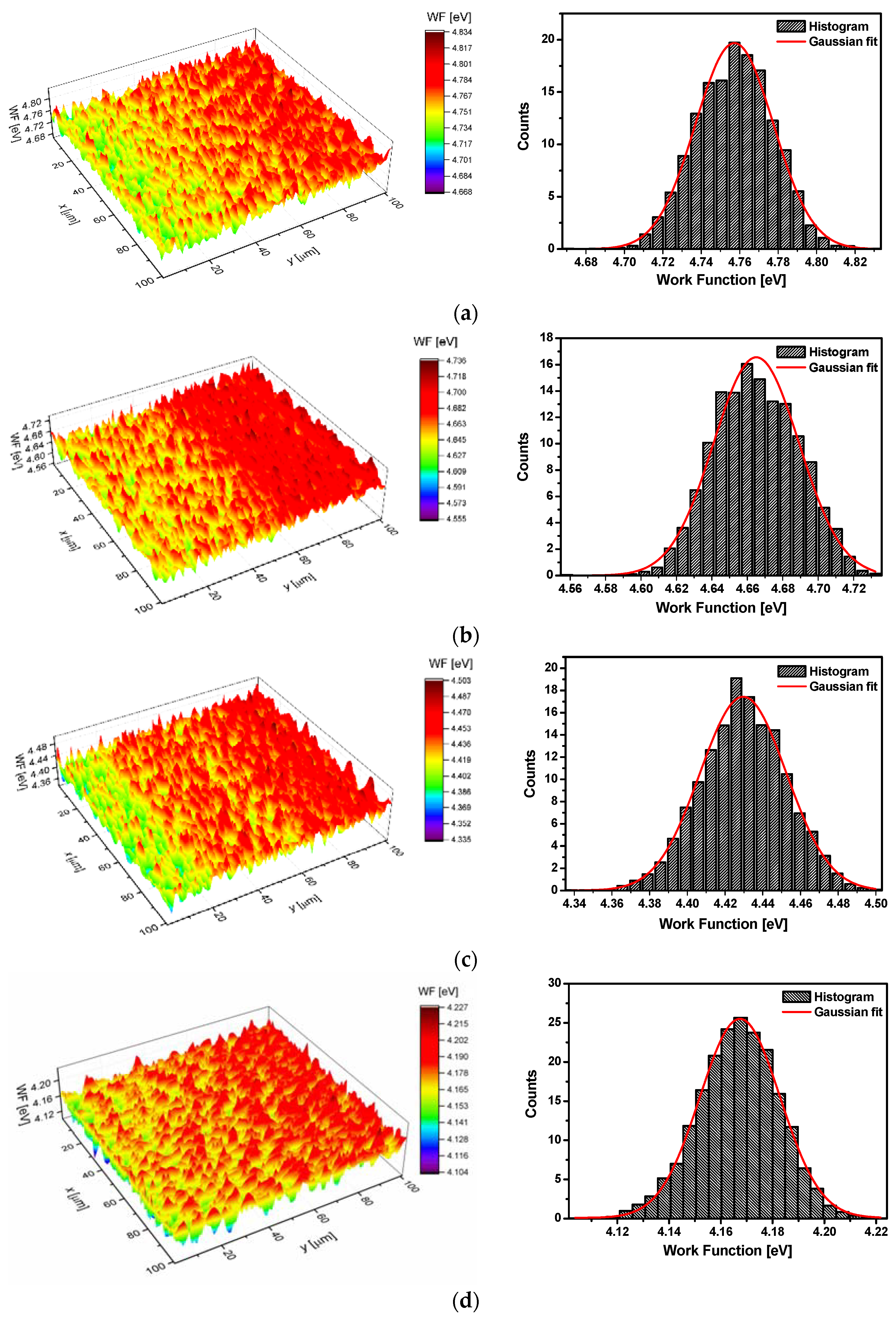
| No. | Sample | Nanohardness H [GPa] | Reduced Young’s Modulus Er [GPa] | Average Roughness Ra [nm] |
|---|---|---|---|---|
| 1 | Pd80Rh20 alloy | 3.90 ± 0.18 | 49.04 ± 1.01 | 65.76 |
| 2 | α Pd80Rh20H | 4.64 ± 0.24 | 152.49 ± 8.58 | 192.89 |
| 3 | α-β Pd80Rh20H | 4.79 ± 0.17 | 157.66 ± 5.75 | 115.02 |
| 4 | β Pd80Rh20H | 4.57 ± 0.34 | 118.82 ± 7.19 | 276.95 |
| No. | Sample | σ2 | |
|---|---|---|---|
| 1 | Pd80Rh20H alloy | 4.76 | (0.02)2 |
| 2 | α Pd80Rh20H | 4.66 | (0.02)2 |
| 3 | α-β Pd80Rh20H | 4.43 | (0.02)2 |
| 4 | β Pd80Rh20H | 4.17 | (0.02)2 |
© 2020 by the authors. Licensee MDPI, Basel, Switzerland. This article is an open access article distributed under the terms and conditions of the Creative Commons Attribution (CC BY) license (http://creativecommons.org/licenses/by/4.0/).
Share and Cite
Losiewicz, B.; Kubisztal, J.; Osak, P.; Starczewska, O. Effect of Hydrogen Electrosorption on Mechanical and Electronic Properties of Pd80Rh20 Alloy. Materials 2020, 13, 162. https://doi.org/10.3390/ma13010162
Losiewicz B, Kubisztal J, Osak P, Starczewska O. Effect of Hydrogen Electrosorption on Mechanical and Electronic Properties of Pd80Rh20 Alloy. Materials. 2020; 13(1):162. https://doi.org/10.3390/ma13010162
Chicago/Turabian StyleLosiewicz, Bozena, Julian Kubisztal, Patrycja Osak, and Oliwia Starczewska. 2020. "Effect of Hydrogen Electrosorption on Mechanical and Electronic Properties of Pd80Rh20 Alloy" Materials 13, no. 1: 162. https://doi.org/10.3390/ma13010162
APA StyleLosiewicz, B., Kubisztal, J., Osak, P., & Starczewska, O. (2020). Effect of Hydrogen Electrosorption on Mechanical and Electronic Properties of Pd80Rh20 Alloy. Materials, 13(1), 162. https://doi.org/10.3390/ma13010162





